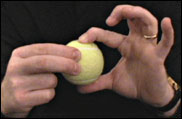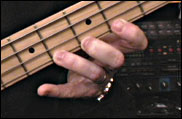 |
 |
| Online Bass Instruction with Rusty Springfield |
 |
|
|
|
|
 |
 |
|
|
|
|
 |
|
|
|
|
A. You can increase the expanse of your fingers by carefully stretching the muscles between them. Place your right hand width-wise in between the first two fingers of your left hand. Slowly expand your right hand, fully stretching the space between the left hand fingers. Hold for a count of ten. Repeat this procedure with each adjacent finger pair. Again be gentle. If this is painful, you may be trying to stretch too much at one time. |
|
|
|
|
 |
|
|
|
|
My World-Famous Tennis Ball Exercise

Squeeze 10 times with each finger while maintaining the correct finger-on-string-position. |
|
|
|
|
B. One simple but effective finger strength builder is an old tennis ball. Used ones are more flexible than brand new ones. Your dog probably has one he'd lend you. Hold the ball firmly in one hand while you gently squeeze with each finger of the other hand. Exercise each finger individually doing ten reps apiece, then switch hands. Most finger dexterity and strength problems can be remedied using this method. This did wonders for me when I was learning to play upright bass. |
|
|
|
|
 |
|
|
|
|
|
Little Finger Trill Exercise

Keep the first three fingers on the string while trilling with the pinky. This one's great for developing finger independence. |
|
|
|
|
|
C. Another terrific left hand strengthener is an exercise I call the "trill drill." You use your bass for this one. Start by placing the first finger of your left hand on the fourth fret of the G string. The note you are playing is a B. Next, trill with your little finger three frets up on the D. If you can do this for five minutes nonstop, you've got a strong pinky. Repeat this exercise with the second and third fingers, on the C and C# respectively. After you've become proficient at this exercise you should be able to punch holes in phone books with a single finger. |
|
|
|
|
 |
|
|
|
|
D. One more exercise which I recommend to gain left hand strength is very simple yet quite effective. Play the A on the fifth fret of the E string with your first finger. Hammer on the B two frets up with your little finger. Move up a fourth (same frets) and play the same pattern on the A string, using your first finger on the D and your pinky on the E. Move to the next two strings and repeat the same exercise in a like manner, so that your whole sequence is A-B, D-E, G-A, C-D and back down again. What's so hard about this, you ask? Try doing it using all four strings in succession at a tempo of, say, 144 BPM (that's beats-per-minute on your metronome) for one minute.
Now do you feel it? I thought so.
|
|
|
|
|
 |
|
|
|
|
|
|
|


